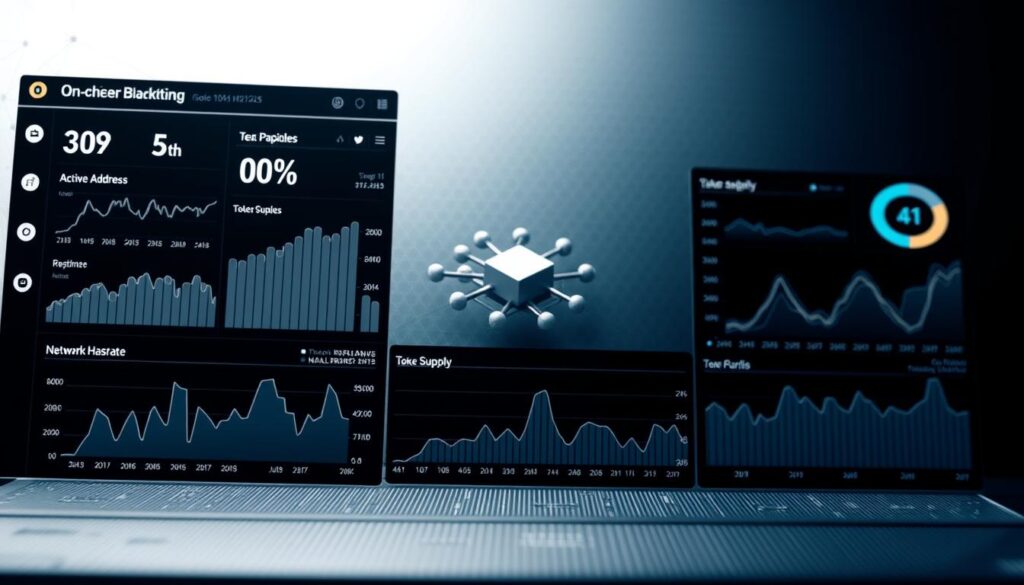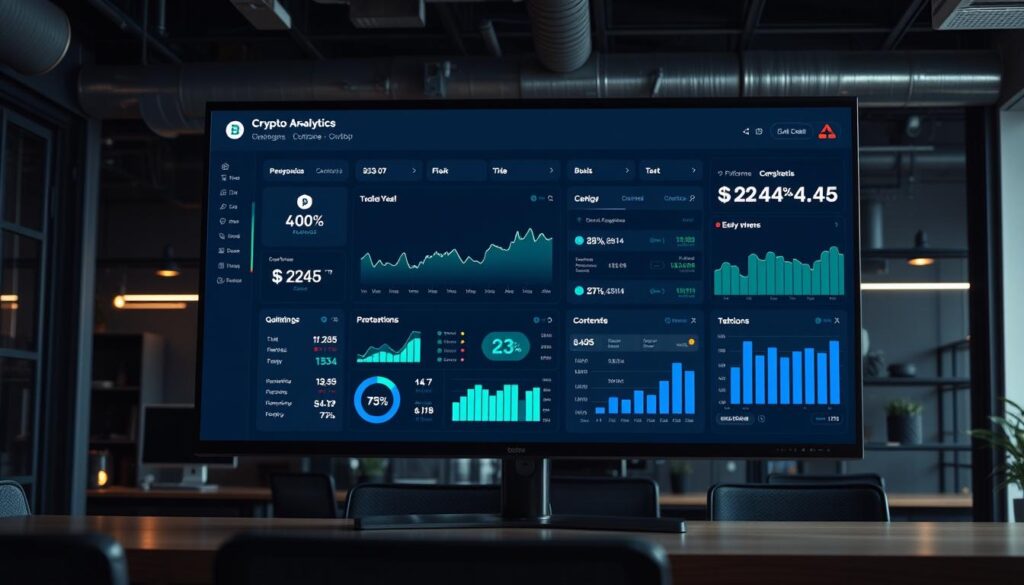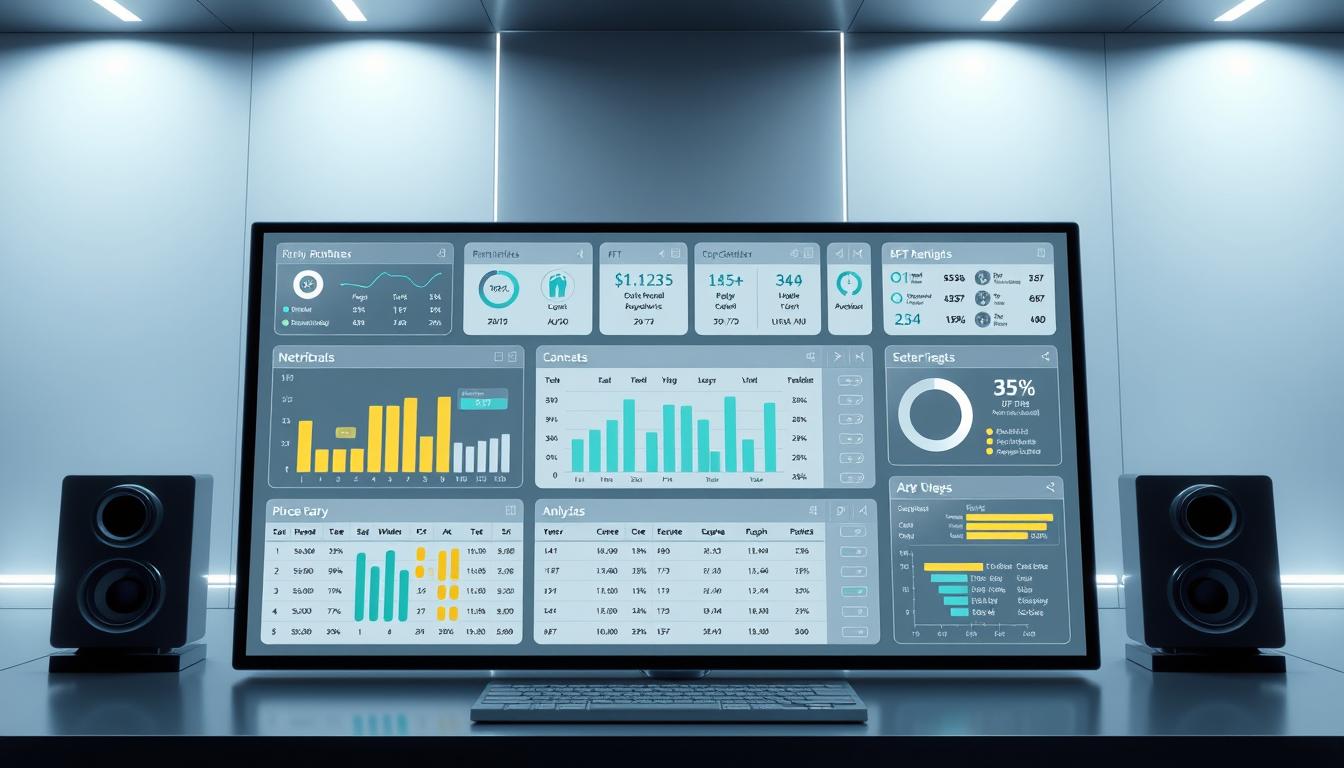Now Reading: Discover the Power of On-Chain Analytics for Crypto Market Research
- 01
Discover the Power of On-Chain Analytics for Crypto Market Research
Discover the Power of On-Chain Analytics for Crypto Market Research

Blockchain technology has revolutionized how we understand financial ecosystems. Unlike traditional systems, it offers complete transparency through publicly accessible transaction records. This visibility creates opportunities to analyze trends with unmatched precision.
Modern investors now rely on real-time data patterns to make informed decisions. These insights reveal everything from asset movements to emerging trends, offering a competitive edge. The shift from conventional analysis methods to blockchain-based tools marks a new era in financial strategy.
One major advantage is the ability to track large transactions instantly. Every action leaves a permanent, tamper-proof record, ensuring data reliability. This level of detail helps identify market shifts before they become mainstream knowledge.
Key Takeaways
- Blockchain transparency provides instant access to transaction histories
- Real-time tracking helps spot trends faster than traditional methods
- Immutable records ensure data accuracy and reliability
- Advanced tools enable monitoring of institutional-level activity
- Data-driven strategies outperform guesswork in volatile environments
This guide will walk you through essential metrics and techniques used by professionals. Whether you’re new to blockchain data or looking to refine your approach, these insights will help you stay ahead.
Introduction: The Rise of Blockchain Data in Market Research
Financial markets have long struggled with incomplete information, but blockchain’s transparency is rewriting the rules. Traditional market analysis relies on delayed reports and fragmented data, creating gaps that savvy investors exploit. This disconnect grows wider in fast-moving digital asset spaces where outdated methods fail to capture real-time shifts.
- Delayed price signals masking true asset value
- Limited visibility into large-scale transactions
- Inability to verify historical patterns reliably
Blockchain technology solves these through its permanent, public ledger system. Every transaction becomes a data point that analysts can track across wallets and timeframes. This eliminates guesswork about asset movements or ownership changes.
| Traditional Analysis | Blockchain Approach |
|---|---|
| Delayed regulatory filings | Real-time transaction tracking |
| Estimated volume reports | Verified address activity |
| Historical price charts | Wallet behavior patterns |
| Third-party audits | Direct ledger verification |
Institutional players now use these capabilities to spot trends weeks before retail traders. By monitoring wallet clusters and network activity, they identify accumulation phases or exit strategies. This shift makes blockchain literacy essential for modern investors.
The permanent nature of distributed ledgers also enables precise historical comparisons. Researchers can analyze past bull markets or crashes with exact transaction timestamps – a game-changer for predictive models.
What Is On-Chain Analysis and How Does It Work?
Decoding blockchain activity reveals hidden market signals that traditional methods miss. At its core, this approach examines public transaction records to uncover patterns in user behavior and asset flows. Unlike conventional tools, it operates on verified data recorded permanently across distributed networks.

Understanding Blockchain Fundamentals
Blockchains act as open databases where every action leaves a trace. Transactions include sender/receiver addresses, timestamps, and amounts transferred. This creates a verifiable timeline of events anyone can audit. Three features make this possible:
- Decentralized validation through consensus mechanisms
- Immutable record-keeping preventing data alteration
- Transparent tracking of digital asset movements
Differentiating From Technical Analysis
While technical methods study price charts, blockchain-based evaluation focuses on real user actions. Here’s how they compare:
| Technical Analysis | Blockchain Evaluation |
|---|---|
| Predicts prices using historical charts | Identifies trends through transaction patterns |
| Relies on trading volume estimates | Uses exact transfer amounts |
| Analyzes market psychology | Tracks wallet-level behavior |
This method shines when monitoring large transactions between institutional wallets. For example, sudden spikes in stablecoin movements often precede major price shifts. By studying these signals, investors gain insights days before traditional indicators react.
Core Metrics and Indicators in On-Chain Analytics
Every blockchain tells a story through numbers. Ten essential measurements reveal patterns in asset creation, movement, and storage. These figures act as vital signs for understanding network health and user behavior.

Primary Metrics and Their Methodologies
Leading platforms like Glassnode and Coin Metrics calculate data differently. For example, total transfer volume might exclude internal wallet transactions on some dashboards but count them elsewhere. This impacts how analysts interpret economic activity.
Annual inflation rates vary based on calculation windows. Proof-of-work chains measure new coin creation daily, while proof-of-stake networks track validator rewards hourly. Such architectural differences require customized tracking approaches.
Transaction Volume, Active Addresses, and More
Three metrics dominate user engagement analysis:
- Daily active addresses: Shows unique participants
- Average transaction size: Indicates institutional involvement
- Supply last active: Reveals dormant asset potential
| Metric | Coin Metrics | Dune Analytics |
|---|---|---|
| New Addresses | 24h rolling window | UTC calendar day |
| Circulating Supply | Excludes lost coins | Includes all mined units |
Network growth becomes clear through daily new addresses, while coin supply distribution exposes concentration risks. Platforms like IntotheBlock adjust these calculations for chains with smart contracts, where single addresses may represent multiple users.
Understanding these variations prevents misinterpretation. A 50% spike in transaction count could signal genuine adoption or simply increased automated transfers. Context separates noise from actionable insights.
Unlocking On-Chain Analytics for Crypto Market Research
Modern investment strategies now blend traditional financial models with innovative blockchain examination techniques. These methods transform raw transaction records into actionable patterns, revealing hidden opportunities in volatile environments.

Traders use real-time ledger information to pinpoint optimal entry and exit points. For example, tracking whale wallet movements often signals impending price swings days before exchanges reflect them. This edge comes from observing actual asset transfers rather than relying on lagging indicators.
| Traditional Research | Blockchain-Enhanced Approach |
|---|---|
| Delayed quarterly reports | Minute-by-minute network activity |
| Estimated investor sentiment | Verified holder behavior metrics |
| Centralized data sources | Decentralized verification systems |
Sentiment tracking through transfer patterns offers another advantage. Large stablecoin deposits to exchanges frequently precede bullish trends, while mass withdrawals may indicate caution. Platforms like Techloy demonstrate how combining these signals with technical charts creates robust trading frameworks.
Institutional teams automate alerts for unusual wallet activity, while individual investors focus on supply distribution metrics. Both approaches rely on the same truth: blockchain’s transparency provides measurable advantages over conventional guesswork.
By merging time-tested strategies with ledger-based evidence, market participants build resilient portfolios. This fusion turns chaotic price action into calculated, data-backed decisions.
Exploring Issuance Metrics and Inflation Dynamics
Digital assets derive their value from carefully engineered supply mechanisms. These systems balance scarcity with network security, creating predictable economic models. Two leading chains demonstrate contrasting approaches to managing coin creation and circulation.
Bitcoin’s Supply Schedule and Halvings
Bitcoin’s code enforces a strict 21 million coin cap through programmed halvings. Every 210,000 blocks (~4 years), mining rewards drop 50%. This metric ensures controlled supply growth, with recent halvings arriving faster due to rising mining power.
Accelerated block times tighten available coins sooner than projected. Investors track these events through fundamental valuation metrics, anticipating reduced selling pressure from miners post-halving. Historical data shows price rallies often follow reduced issuance rates.
Ethereum’s Inflation Trends and EIP-1559 Impacts
Ethereum took a dynamic approach with its 2021 EIP-1559 upgrade. This change burns transaction fees instead of paying them to miners. During peak usage, more ETH gets destroyed than issued – flipping inflation to deflation.
Post-upgrade data reveals annualized inflation dropped from ~5% to 2%. The network now responds to user activity: high demand reduces circulating supply, creating upward price pressure. This feedback loop rewards long-term holders during adoption spikes.
Analyzing Transaction Volume and Transfer Metrics
Accurate transaction measurement separates signal from noise in blockchain evaluation. Raw data often includes technical operations that distort true economic activity. Without proper filtering, analysts risk misjudging network usage and value flows.

Filtering Out Change Transactions and Coinbase Transfers
Bitcoin’s wallet software creates change outputs during payments – like getting digital “coins” back after a purchase. These internal transfers inflate volume metrics by up to 50x on high-activity days. Major platforms handle this differently:
| Data Provider | Methodology |
|---|---|
| Coin Metrics | Automatically excludes change outputs |
| Glassnode | Includes unadjusted transfers |
Coinbase transactions (mining rewards) also skew results. Unlike user-initiated transfers, these automatic protocol payments don’t reflect market behavior. Filtering them reveals clearer patterns in genuine activity.
Measuring Economic Activity on the Blockchain
Advanced analysis groups related addresses through cluster tracking. This technique identifies single users controlling multiple wallets, preventing double-counted transactions. The process involves:
- Mapping address interactions over time
- Identifying common spending patterns
- Separating exchange wallets from individual users
These methods expose real network usage. A 10,000 BTC transfer between exchange wallets impacts markets differently than small peer-to-peer payments. Proper filtering turns chaotic data into actionable intelligence about actual value movement.
Examining Active Addresses and User Engagement
Active addresses act as the pulse of blockchain ecosystems. These metrics measure how many unique wallets send or receive assets daily. Unlike traditional user counts, they reveal genuine interaction with the network.
Daily new addresses show fresh adoption. When this number spikes, it often signals growing interest during bull markets or protocol upgrades. However, these data points have quirks. Automated systems and single users controlling multiple wallets can distort results.
Analysts use advanced methods to filter noise. Address clustering groups related wallets by behavior patterns. This helps separate real user activity from technical operations. For example:
| Data Challenge | Solution |
|---|---|
| One user, 50 addresses | Cluster analysis links related wallets |
| Exchange bot transactions | Identify automated transfer patterns |
| Test network spam | Filter low-value transactions |
When tracked properly, these metrics correlate with price trends. Rising active addresses often precede rallies as more users engage. Conversely, shrinking numbers may warn of declining network health.
Platforms like Nansen refine this data by labeling institutional wallets. This turns raw numbers into actionable insights about real adoption. By understanding these patterns, investors spot trends before they hit mainstream charts.
Evaluating Market Sentiment Through On-Chain Data
Digital footprints on blockchains reveal more than just transactions—they expose collective psychology. By studying wallet interactions, analysts detect shifts in confidence before they influence price charts. This approach turns raw numbers into a narrative about investor expectations and fears.
Decoding Behavior Through Transaction Clues
Large transfers to exchanges often signal impending sell-offs, while withdrawals suggest long-term holding. These patterns create measurable indicators:
- Spikes in stablecoin deposits precede bullish trends
- Dormant wallet activation warns of potential distribution
- Cluster movements reveal institutional positioning
Metrics like coin days destroyed quantify how old assets move. When long-held coins suddenly trade, it indicates shifting sentiment among veteran holders. Platforms track these signals through customizable dashboards.
| Retail Behavior | Institutional Patterns |
|---|---|
| Small, frequent trades | Batch transactions |
| Reaction to news events | Pre-emptive positioning |
| Exchange-focused activity | OTC wallet movements |
Address clustering techniques separate noise from meaningful data. By grouping related wallets, analysts identify accumulation phases invisible to traditional methods. This market sentiment gauge often predicts price swings 48-72 hours before exchanges reflect them.
Historical analysis adds depth to real-time observations. Comparing current transaction flows to past bull/bear cycles helps validate emerging trends. When multiple metrics align—like rising network growth and stablecoin inflows—confidence in trend predictions strengthens.
How Blockchain Explorers and Data Providers Enhance Analysis
Specialized tools form the backbone of modern blockchain evaluation. Platforms like Blockchair and Etherscan act as search engines for transaction histories. They let users track wallet balances, verify transfers, and monitor network status in real time.
Cross-platform providers face unique challenges. Services like Glassnode standardize data across different ledgers—a complex task. Chains vary in architecture, requiring customized approaches for comparing metrics like active addresses or transaction volumes.
New projects often lack immediate support. It takes weeks or months for providers to integrate fresh blockchain information. This delay stems from:
- Custom code requirements for each ledger
- Validation of historical records
- Metric calibration against existing frameworks
| Blockchair (Explorer) | Glassnode (Provider) |
|---|---|
| Raw transaction feeds | Processed metrics |
| Single-chain focus | Multi-chain comparisons |
| Immediate updates | Standardized datasets |
These differences impact analysis outcomes. A supply metric on one platform might exclude lost coins, while another counts all mined units. Savvy users cross-reference multiple tools to confirm trends.
Choosing the right service affects decision quality. Some platforms excel at spotting whale movements, while others track retail patterns. Understanding these strengths prevents misguided conclusions in fast-moving environments.
Unpacking the Role of Cross-Asset Data Providers
Comparing activity across multiple ledgers demands more than basic number-crunching. Cross-asset data providers face unique technical hurdles when creating standardized metrics. Chains like Bitcoin and Ethereum store information differently – from timestamps to transaction structures – requiring tailored engineering solutions.
These specialists develop unified frameworks to measure transfers, wallet activity, and network growth. A Bitcoin transaction’s value calculation differs from Ethereum’s gas-powered operations. Providers adjust methodologies to ensure apples-to-apples comparisons between assets.
The process involves mapping varied architectures into consistent datasets. Some platforms build translation layers that convert chain-specific data into universal formats. This lets investors compare metrics like daily active addresses across unrelated networks accurately.
Reliable cross-chain analysis helps spot emerging trends faster. When multiple networks show similar patterns in large transfers or wallet creation, it signals broader market shifts. These insights empower strategic decisions backed by verified, multi-source evidence.















